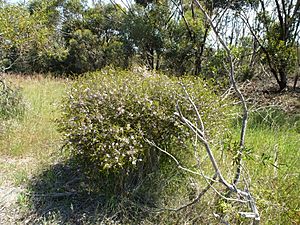Melaleuca camptoclada facts for kids
Quick facts for kids Melaleuca camptoclada |
|
|---|---|
 |
|
| M. camptoclada in the Stirling Range National Park | |
| Scientific classification | |
| Genus: |
Melaleuca
|
| Species: |
camptoclada
|
Melaleuca camptoclada is a special kind of shrub. It belongs to the myrtle family, which is called Myrtaceae. This plant is endemic to the south-west part of Western Australia. This means it grows naturally only in that area and nowhere else in the world!
Scientists first officially described Melaleuca camptoclada in 1990. They were reviewing a group of similar plants in the Melaleuca genus. They discovered that what they thought was one species, Melaleuca laxiflora, was actually ten different ones! Two of these newly identified species were M. camptoclada and M. ctenoides.
Contents
What Melaleuca camptoclada Looks Like
Melaleuca camptoclada is a shrub that can grow up to about 3 m (10 ft) tall. Its leaves and branches are mostly glabrous, which means they are smooth and don't have any hairs.
The leaves are small, usually about 2.9–5.5 mm (0.1–0.2 in) long. They are also about 1.5–1.8 mm (0.06–0.07 in) wide. The shape of the leaves is elliptical, like a tiny oval.
Flowers and Fruit
The flowers of Melaleuca camptoclada are a pretty mauve (purple) color. They grow in small clusters or spikes. These flower clusters can be up to 16 mm (0.6 in) across. Each cluster has between 5 and 15 individual flowers.
The petals of the flowers are 1.5–2.4 mm (0.06–0.09 in) long. They fall off once the flowers open up. Inside the flower, there are five groups of stamens (the parts that produce pollen). Each group has 9 to 16 stamens.
This plant usually flowers from September to November. After the flowers, it produces woody capsules as fruit. These capsules are small, about 2.5–3.5 mm (0.098–0.14 in) long.
How It Was Named
Melaleuca camptoclada was officially described in 1990 by a scientist named F.C.Quinn. The plant was found near the Stirling Ranges.
The second part of its scientific name, camptoclada, comes from two Greek words. Camptos means "flexible" or "curved." Clados means "a shoot" or "a branch." This name describes how the branches of this plant tend to be flexible or curved.
Where It Grows
This type of melaleuca plant is found in specific areas of Western Australia. These areas are called the Esperance Plains, Jarrah Forest, and Warren biogeographic regions.
It likes to grow in certain types of soil. You can often find it in gravelly sand or in clay loam.
Conservation Status
Good news! The Melaleuca camptoclada is currently listed as "not threatened." This means it is not in danger of disappearing. The Government of Western Australia Department of Parks and Wildlife keeps track of its status.
Images for kids
-
Habit in the Stirling Range National Park




